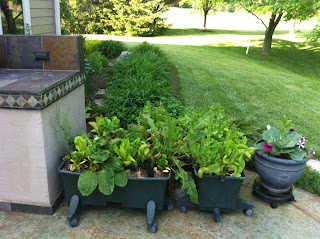 |
| Potted veggies with flowers in foreground, herb and veggie garden in flower bed in background |
Saturday, January 16, 2016
You can start a garden at any time in spring, summer or fall.
You may be wondering how to get started..........
Step 1-I think the best way is to make a list of what you like to eat, then see which of your favorites are best to start in your garden in which season. There is no time like the present to get moving on your gardening dreams. For an overview of plants by season, Planning for a four season garden If you want to start with the easiest plants to grow, do what I did and start a kitchen herb garden. Herbs thrive under neglect. Start a kitchen herb garden!
The biggest mistake beginners make is starting too big. For your first garden, herbs and 5-7 of your favorite veggies are plenty to get your feet wet. How do you decide what to grow?
Step 2-Now that you have your list, take a look at your garden, patio, deck, porch, front yard to see how much space you have that gets 6 hours of sun a day. There are so many dwarf varieties of every kind of vegetable to grow in pots or small spaces that you should not be put off thinking you don’t have enough space! Plus growing compact varieties significantly lessens the work by using less space that you have to care for. A real win-win.
Step 3-Buy your supplies for your garden bed or pot. Pots are easy-just buy some organic potting soil and the decorative pot. Most potting soils come with fertilizer already mixed in. You do not want to use garden soil as it is too dense for pots. Make sure you buy the right size pot for the vegetable you are growing. For the size of pot needed by veggie type, check out this blog Decorative container gardening for edibles
 |
| Potted veggies and fruit trees with flowers on patio |
If you are going to plant in your garden bed, your mulched flower bed is a great choice to add veggies, too! If planting in your flower bed or garden, the best thing to do is a soil test (you can buy a kit or take it to your local co-op extension office). If this just seems too much trouble, buy an organic balanced fertilizer and compost. Pull back your existing mulch, apply a 2” thick layer of compost, top with the fertilizer (following the label’s directions) and you are ready to plant.
For more on preparing your garden bed for planting, Weed free, self fertilizing, till free garden beds for a deep dive or for a quick overview Easy ways to make a new vegetable garden bed
Step 4-Buy your plants. I prefer to buy plants that are raised without chemicals so I look for an organic nursery to see if they have what I want. Your local farmers market usually has plants for sell, too, in the spring and early summer. My next stop is my local nursery or big box hardware store. Choose the plants that are green and look sturdy. If they already have blooms, be sure to remove them. You want all the energy of your plants going into good roots initially.
Step 5-Plant! Water each plant well before planting. The best time to plant is before a rain or cloudy days. Gives the plants a little time to get their roots jump started.
For potted veggie or herbs, fill the pot with organic potting soil, water to get the potting soil settled, plant the veggie, and water again. You can top with mulch to keep lengthen the time between waterings. I also plant flowers in my pots to add color and attract beneficial insects.
I like to put a handful of worm castings into each hole with the new plant. Worm castings have lots of beneficial microbes in them that helps the plants absorb nutrients from the soil.
Step 6-Monitor and water. Keep an eye on your plants. They may look sad the first week if it is really hot when they first go into the ground. Consistent water is the key for success. Like a lawn or flowers, the best time to water is in the mornings. When you water your flowers, water your veggies and herbs. Remember, the biggest cause of plant death is overwatering. If the soil is moist a couple of inches down, your plants are fine. I usually don't start watering in our Zone 6/7 garden until sometime in later June. You may need to start watering pots sooner.
One watch out on watering, many summer crops are susceptible to leaf fungus, like cucumbers, zucchini, squash, and tomatoes. Be sure to water at the base of the plant and not the leaves.
No comments:
Post a Comment